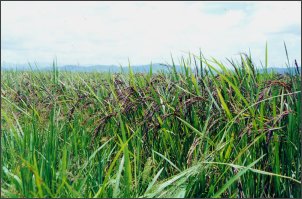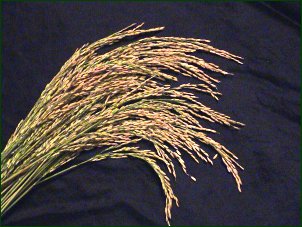Modification
of Starches in Rice Flours by Acetylation.
ONANONG
NAIVIKUL1, Eakaphan Keowmaneechai2
 Native
starches show considerable retrogradation
at low temperature. Consequencely, some
food products produce undesirable characteristics.
Rice and waxy rice starches, therefore,
were modified by acetylation at 20, 30,
40 and 50 oC and pH 7.5-8.0,
8.0-8.5, 8.5-9.0 and 9.0-9.5 to improve
their properties. It was found that the
optimum modified condition was 30 oC
with pH range at 8.0-8.5. The amount of
acetic anhydride used for acetylation
showed linear relations to the acetyl
contents of modified starches. When starches
were modified with desired acetyl percentages,
0.6, 1.5 and 2.4 %, the results showed
non-significantly difference at 95 %.
Native
starches show considerable retrogradation
at low temperature. Consequencely, some
food products produce undesirable characteristics.
Rice and waxy rice starches, therefore,
were modified by acetylation at 20, 30,
40 and 50 oC and pH 7.5-8.0,
8.0-8.5, 8.5-9.0 and 9.0-9.5 to improve
their properties. It was found that the
optimum modified condition was 30 oC
with pH range at 8.0-8.5. The amount of
acetic anhydride used for acetylation
showed linear relations to the acetyl
contents of modified starches. When starches
were modified with desired acetyl percentages,
0.6, 1.5 and 2.4 %, the results showed
non-significantly difference at 95 %.
 The modified
starches having acetyl group of 0.6, 1.5
and 2.4 % showed more desirable properties
as compared to their native counterparts.
It was found that most of them were in
granule form, their brightness were increased
but yellow color was decreased. Their
gelatinization and pasting temperature
were decreased, whereas peak viscosity
was higher by the increasing of acetyl
content. Their solubility and swelling
power were also increased. After freeze-thawing,
the clarity were slightly changed and
the filtrate contents were reduced.
Rice, waxy
rice flours and their modified starches
were used for making Thai-styled custard
and oyster sauce, respectively. Their
products were accepted at the highest
scores for 2.4 % acetyl group of modified
starches after the first freeze-thaw cycle
for Thai-styled custard and the ninth
freeze-thaw cycles for oyster sauce.
The modified
starches having acetyl group of 0.6, 1.5
and 2.4 % showed more desirable properties
as compared to their native counterparts.
It was found that most of them were in
granule form, their brightness were increased
but yellow color was decreased. Their
gelatinization and pasting temperature
were decreased, whereas peak viscosity
was higher by the increasing of acetyl
content. Their solubility and swelling
power were also increased. After freeze-thawing,
the clarity were slightly changed and
the filtrate contents were reduced.
Rice, waxy
rice flours and their modified starches
were used for making Thai-styled custard
and oyster sauce, respectively. Their
products were accepted at the highest
scores for 2.4 % acetyl group of modified
starches after the first freeze-thaw cycle
for Thai-styled custard and the ninth
freeze-thaw cycles for oyster sauce.

Introduction
Native
starches show considerable retrogradation
at low temperature. Consequencely, some
food products produce undesirable characteristics.
The modification could solve some of this
characteristics. Such as the chemical
modification could provide more stability
for freeze-thaw condition by using acetylation
reaction of starch.
Materials
& Methods
Modified
starch in rice and waxy rice flours by
using acetylation method (Wurzburg, 1964).
The variation of the conditions as follow:
1) Differences
temperature (20, 30, 40 and 50 oC)
2) Differences
pH (7.5-8.0, 8.0-8.5, 8.5-9.0 and 9.0-9.5)
3) Differences
acetyl groups (0.6 %, 1.5 % and 2.4 %)

Results
& Discussion
The modification
of starch in rice and waxy rice flour,
using acetylation method were compared
between differences temperature (20, 30,
40 and 50 oC). The results
showed that there were non significantly
differences among temperature changes.
All modification starch in both rice and
waxy rice flour caused the lower initial
pasting temperature and higher peak viscosity
than the native flour (Jarowenko, 1987).
The suitable temperature for both rice
and waxy rice flours to be modified should
be 30 oC which was similar to room temperature,
shown in Figure 1a and Figure 2a, respectively.
The variation
of pH (7.5-8.0, 8.0-8.5, 8.5-9.0 and 9.0-9.5)
during the acetylated modification of
starch in rice and waxy rice flours showed
non significantly difference. The suitable
pH should be 8.0-8.5 which was slightly
alkaline, shown in Figure 1b and Figure
2b, respectively.
The higher
of acetyl group in the modified starch
in rice and waxy rice flour caused lower
initial pasting temperature and higher
viscosity (Jarowenko, 1987), shown in
Figure 1c and Figure 2c, respectively.
The amount
of acetic anhydride used for acetylation
showed linear reations to the acetyl contents
of modified starch in rice flour (Table
1 and Figure 3).
The starch
granules of modified starch in rice and
waxy rice flours showed somewhat differences
from native starch granules (Figure 4
and 5). The swollen granules dued to the
alkaline condition during reaction and
the shrinked granules due to the drying
process could be seen (Jarowenko, 1987).
The Thai-styled
custard made from modified starch in rice
flour at different acetyled groups (0.6,
1.5 and 2.4 %) were compared to native
rice flour. The taste panel accepted the
product from 2.4 % acetyled group modified
starch in rice flour after the first freeze-thaw
cycle at the highest score (Table 2).
The oyster
sauce made from 2.4 % acetyled group modified
starch in waxy rice flour after the ninth
freeze-thaw cycle was accepted by the
taste panel at the highest score as compared
to native waxy rice flour and the other
two concentrations (0.6 and 1.5 % acetyled
group), shown in Table 3.

Conclusions
The modification
of rice starch in rice and waxy rice flours
could be produced by using acetylation
methods. The products made from these
modified starch in rice and waxy rice
flours were stable for freeze-thaw cycle,
depended on the kind of products.
Literature
Cited
Jarowenko,
W. 1987. Acetylated starch and miscellaneous
organic esters. In: Modified Starches:
Properties and Uses. Eds. O.B. Wurzburg.
CRC Press, Inc., Boca Raton, Folrida.
pp. 55-77.
Wurzburg,
O.B. 1964. Acetylation. In: Method in
Carbohydrate Chemistry. Eds. R.L.Whistler,
R.J. Smith, J.N. BeMiller and M.L. wolfrom.
Academic Press, Inc., New York. pp. 286-288.
Table
1 Comparison of the acetic anhydride
used for reaction and the acetyl contents
of modified starch in rice flour.
| kind
of flour
| %
acetic anhydride
| %
acetyl group
|
| Rice
| 3.00
5.00
7.00
9.00
| 0.946
1.444
1.986
2.512
|
| Waxy
Rice
| 3.00
5.00
7.00
9.00
| 0.946
1.517
2.089
2.614 |
Table
2 Taste panel results for Thai-styled
custard made from rice flour and modified
starch in rice flour1.
| Characteristics
|
Acceptance
products from differences percent
acetyl group of modified starch
in rice flour
|
| 0
%
| 0.6
%
| 1.5
%
| 2.4
%
|
| Syneresis
| 3.60
c
| 4.07
c
| 5.33
b
| 7.13
a
|
| Smoothness
| 4.20
b
| 5.07
ab
| 6.07
a
| 6.13
a
|
| Viscosity
| 4.00
b
| 4.33
b
| 5.93
a
| 6.80
a
|
| Spreading
| 5.80
b
| 5.80
b
| 6.33
ab
| 7.00
a
|
| Texture
| 4.00
c
| 4.27
c
| 5.53
b
| 6.50
a
|
| Flavor
| 4.53
b
| 5.07
b
| 6.20
a
| 6.33
a
|
| Total
Acceptance
| 4.17
c
| 4.73
c
| 5.73
b
| 6.90
a |
1
Results of product after the first
freeze-thaw cycle from 1-9 Hedonic score,
1 = mostly dislike, 9 = mostly like
Table
3 Taste panel results for Oyster sauce
made from waxy rice flour and modified
starch in waxy rice flour1.
| Characteristics
|
Acceptance
products from differences percent
acetyl group of modified starch
in rice flour
|
| 0
%
| 0.6
%
| 1.5
%
| 2.4
%
|
| Clearness
| 6.47a
| 6.80a
| 6.87a
| 6.53a
|
| Smoothness
| 7.20a
| 6.73a
| 6.93a
| 6.80a
|
| Viscosity
| 5.73b
| 6.67ab
| 7.07a
| 7.20a
|
| Flavor
| 5.47a
| 6.27a
| 5.47a
| 6.20a
|
| Total
Acceptance
| 5.80b
| 6.73ab
| 6.67ab
| 7.13a
|
1
Results of product after the ninth
freeze-thaw cycle from 1-9 Hedonic score,
1 = mostly dislike, 9 = mostly like
|



